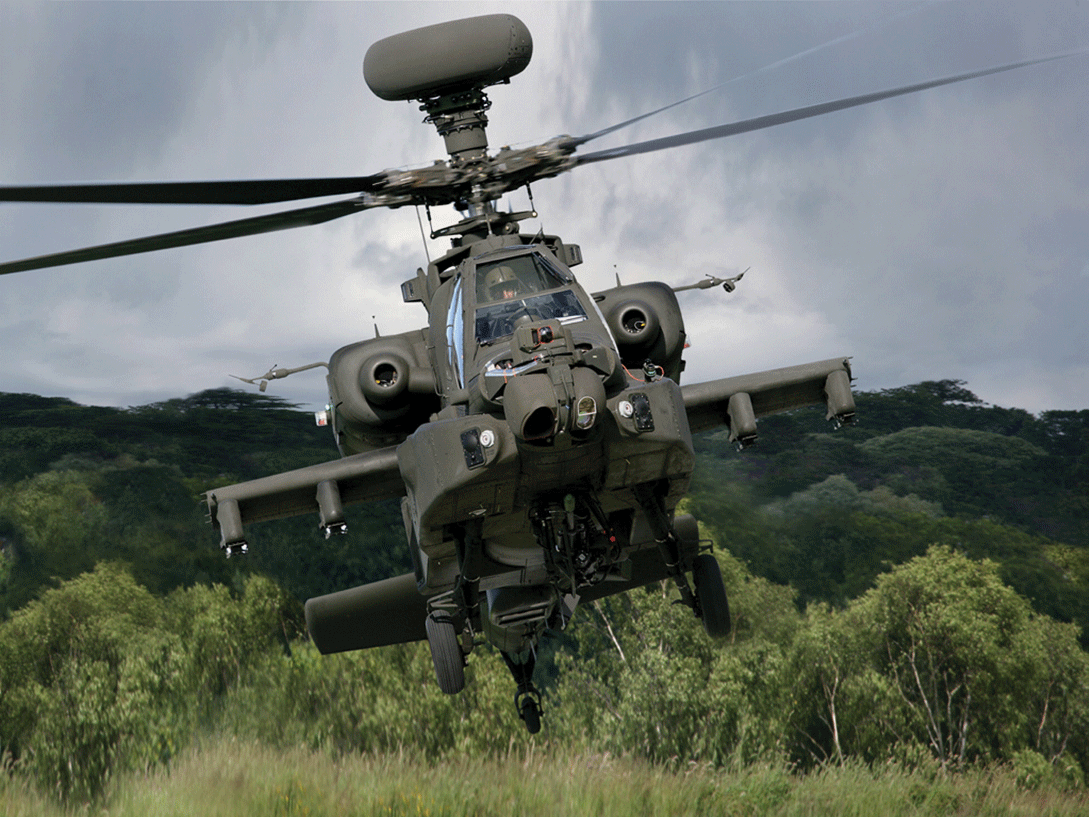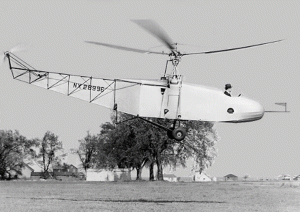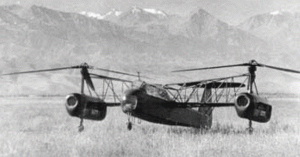Development of the pure helicopter remained painstakingly slow. The first closed circuit kilometre was flown by a helicopter only in 1924, more than 16 years after the first rotary wing flight. Its speed was only eight kmph, three times slower than Roger Bannister’s four-minute-mile! Equally dismally, the world altitude record for a helicopter in 1930, 23 years after the first flight, was only 18 metres! By the mid-1930s, development began to accelerate. The Germans produced a jet helicopter in 1942 built by Friedrich von Doblhoff but it was never mass produced and its prototype was captured by US forces at the end of World War II. The Germans were undoubtedly the pioneers in perceiving the helicopter as a combat platform, but the War took its toll on German helicopter development efforts and prevented large scale development of any type.
The trench warfare stalemate on the western front during World War I led to the debate in the 1930s on the role of the tank, eventually leading to mechanised forces assuming the role of the cavalry. By World War II, the prerogative of manoeuvre was restored to the commander in the field. However, the debate over the battlefield role of the military helicopter initiated at about the same time, persisted well into the 1980s and indeed, continues to engage military thinkers even today.
By World War II, the prerogative of manoeuvre was restored to the commander in the field…
In order to relive the evolution of the helicopter as a combat platform and look into the future, we must fast forward our way through the oft-cited artistic creations of Leonardo da Vinci in 1483, the first rotary wing model of Russian Mikhail Lomonosov’s model that actually flew in 1754, Frenchmen Louis and Jacques Breguet’s flying machine that was the first to lift itself and a pilot off the ground in 1907, Spaniard Juan de la Cierva’s autogyro in 1923, Spanish-born Pescara’s counter-rotating blade helicopter in 1925 to Russia-born American Igor Sikorsky’s first practical helicopter which flew on May 13, 1940. All these inventors deserve a place in history alongside the Wright brothers. Helicopters have evolved and co-existed with fixed-wing platforms. While rotary wing has remained a sub-set of the larger picture, its evolution has established its own paradigms as it evolved, matching the developments in fixed-wing aviation at some planes, intersecting at others, occasionally existing unencumbered.
The Formative Years
Breguet’s primitive helicopter, the first to lift a man off the ground in 1907, lagged behind a similar event by a fixed wing aircraft four years earlier. The problem of countering the rotor torque, however, remained unresolved. This was later solved by introduction of the tail rotor and the first machine to do so was introduced by Boris Yuriev in 1912.
Unfortunately, his machine never got off the ground. World War I was significant to this narrative due to two helicopters, the PKZ-1 and PKZ-2. The PKZ-1 was electric powered and on one of its test flights, carried three men aloft to a height of 20 feet in tethered flight. The PKZ-2 was unique as it had an observer’s cockpit above its rotors that were contra-rotating. On one of the test flights, it remained aloft for half an hour. The early 1920s saw Cierva’s autogyro, a fixed wing aeroplane with a wind milling rotor. Although it could not take off vertically or hover, it represented a major advancement in rotary wing design. Cierva never designed a pure helicopter yet he has a place in history as he was the first to solve the problem associated with unequal lift on different blades of a rotor system by incorporating “flapping” and “dragging” which permit individual blades to flap above or below their mean position in a rotor disc as also to lead or lag behind their nominal position on the disc. One of Cierva’s machines was the first to cross the English Channel. His designs were built in Britain, France, Germany and the US. The C-30 autogyro was used for limited military purposes from 1935 onwards.
Development of the pure helicopter remained painstakingly slow. The first closed circuit kilometre was flown by a helicopter only in 1924, more than 16 years after the first rotary wing flight. Its speed was only eight kmph, three times slower than Roger Bannister’s four-minute-mile! Equally dismally, the world altitude record for a helicopter in 1930, 23 years after the first flight, was only 18 metres! By the mid-1930s, development began to accelerate. Breguet rejuvenated helicopter development in 1936 with his innovation of co-axial contra-rotating rotors. Focke Wolfe of Germany produced the FW-61, a helicopter with a hinged rotor system that broke all existing records in 1937. In 1939, the Germans developed the F-1282 Kolibri, which first flew with the German Navy in 1941 for anti-submarine patrolling. Some aver that the Kolibri was the first military helicopter in the world. The Germans also produced a jet helicopter in 1942 built by Friedrich von Doblhoff but it was never mass produced and its prototype was captured by US forces at the end of World War II. The Germans were undoubtedly the pioneers in perceiving the helicopter as a combat platform, but the War took its toll on German helicopter development efforts and prevented large scale development of any type.
Helicopters have evolved and co-existed with fixed-wing platforms.
Igor Sikorsky, a Russian émigré, has the credit for designing the first military helicopter to enter series production. He is said to have built his first helicopter in Russia in 1909 although the design failed. After fleeing Russia during the Bolshevik Revolution, he established the Sikorsky Aero Engineering Corporation in the US and produced the VS-300 in 1939 and the R-4 in 1942, of which 130 were produced and used for Search And Rescue (SAR). Apart from being a pioneer in designing helicopters, he was also the main force behind the establishment of the helicopter industry in the US.
Back in the USSR, helicopter development progressed in isolation from the rest of the world. There were three trends in development of helicopters; a single engine machine with two contra-rotating rotors on twin booms, one on each side of the fuselage; a large eight-engine, eight-rotor combat design and a single rotor design with two dual propellers mounted on the nose and tail to neutralise torque. According to one account, during 1932, the TsAGI-1-EA flew up to an altitude of 605 metres. Although this beat the official world record of 18 metres, this news was kept from the world due to the Soviet preoccupation with secrecy. Inspired by Cierva, Soviet engineers produced the KASKR-1, TsAGI 2-E, A4, A6, A7, A8, A9, A10, A13, A14 and A15 before World War II. These autogyros had limited success but the A8 deserves special mention because its rotor was designed to tilt so that the autogyro could be steered in flight independent of the direction in which the fuselage was pointing. During the 1930s a wave of arrests affected leading pioneers in the Soviet helicopter design field and progress became stunted. The 1940s saw the advent of the 2MG Omega, the world’s first twin-engine helicopter. Two improved prototypes, the G2 Omega II and G3 Omega III were also produced but establishment apathy and indecisiveness led to their fading into history.
The period ending with World War II is perhaps notable for Sikorsky’s V-300 design, a single rotor system with flapping and dragging hinges, producing varying amounts of lift controlled by altering the angle of attack collectively on all rotor blades. The whole rotor system could be tilted forward, rearward or sideways. A small tail rotor was provided to counter torque forces as well to serve as a rudder for directional control. Produced in 1941, it still remains the most widely used helicopter design in the world especially for those employed in combat roles.
Post World War II
In the 1940s, helicopters were fragile, vulnerable to ground fire, expensive to operate, carried much less load than fixed-wing aircraft for same fuel consumption, had complicated rotor designs, and were not developed as much as fixed-wing aircraft. Civilian interest was thus negligible. Military attention, with a different cost-benefit paradigm, was however won over by the helicopter as a result of the War. Technology improvements provided the necessary impetus to design, while historical events clamoured for a military machine with the attributes of the helicopter.
The 1940s saw the advent of the 2MG Omega, the world’s first twin-engine helicopter.
Unlike other military platforms, the helicopter was first used on the battlefield not in offensive roles but for casualty evacuation. The War in Indochina was perhaps the first such demonstration of the helicopter. The French used the Hiller-360 for medical evacuation and observation while the WS-51 Dragonfly and the WS-55 Whirlwind were used for troop and cargo transportation. The British also made extensive use of these two types during the campaign in Malaya beginning late 1940s and continuing through the 1950s. The British experience with the helicopter in counter-insurgency roles led to their using the helicopter during a two-year operation in Cyprus (late 1950s), Brunei (1962), for three years against Indonesian infiltrators in Malaysia (1963 onwards), and culminated in Northern Ireland when it became a hotbed of insurgency.







